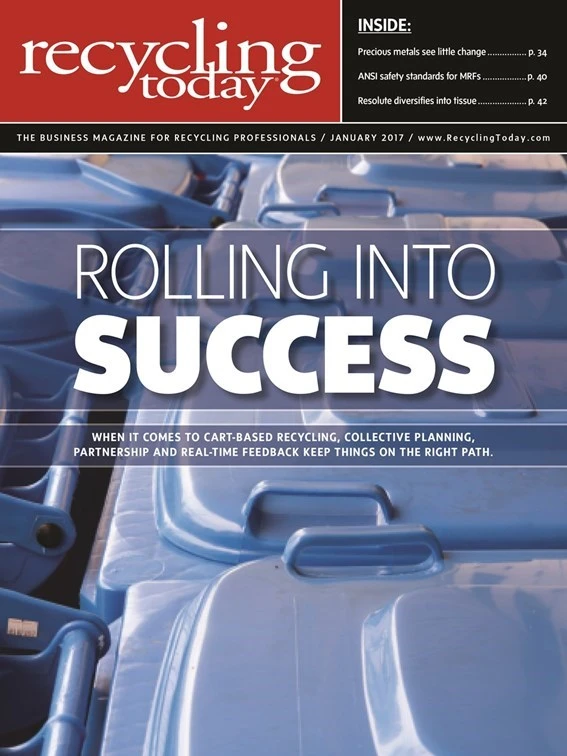Closed Loop Fund releases impact report

Closed Loop Fund, an investment fund that finances recycling infrastructure and sustainable manufacturing technologies to advance the circular economy, has released its first public progress “Impact Report,” available at http://bit.ly/2fWpVqa.
Details from the report reveal investment opportunities in the recycling industry that deliver environmental and financial returns for cities, companies and private investors, despite the headwinds of low commodities prices.
In addition, the report unveils a new umbrella, called the Closed Loop Partners, that includes Closed Loop Fund; Closed Loop Ventures, a venture fund that invests in sustainable consumer goods, advanced recycling technologies and services related to the circular economy; and Closed Loop Foundation, which funds research and development of technologies and business models focused on building the circular economy. Closed Loop Partners is an investment firm using venture capital and project finance, through the Closed Loop Fund, to commercialize and scale solutions for the circular economy.
According to the report, The Closed Loop Fund has invested nearly $20 million in nine projects, unlocking more than $50 million in co-investment from municipalities, banks and impact investors; it has received more than 150 inquiries for more than $350 million in financing; four live projects already have diverted nearly 50,000 tons of material, avoiding the equivalent of 112,000 metric tons of greenhouse gas emissions; the fund has received 100 percent on-time loan repayments; and through the fund, municipalities have realized nearly $250,000 in economic benefits.
Ron Gonen of Closed Loop Partners says, “We have focused our investments on municipalities and companies that are doing what works—writing smart contracts, showing commitment and leadership, and building forward-thinking business models and operations.”
Closed Loop Fund says it is committing 20 percent of its capital to develop robust end markets to ensure the system economics work.
FCC secures contract in Dallas suburb

The University Park (Texas) City Council has awarded Madrid-based FCC, a global environmental services, infrastructure and water management group, a five-year service contract for the treatment and marketing of the city’s recyclables. The materials will be processed at a single-stream material recovery facility (MRF) in Dallas that FCC is building and is scheduled to open Jan. 1, 2017.
The city of University Park in Dallas County has a population of approximately 24,000 residents. FCC will collect and process approximately 3,200 tons of recyclables per year from residents. The service commencement date of the contract is Jan. 2, 2017, with a possible extension for an additional five years.
FCC was awarded the contract to build the state-of-the-art MRF on the McCommas Bluff Landfill site in southern Dallas in November 2015, with construction starting in 2016.
Inigo Sanz, CEO of FCC Environmental Services, the U.S. subsidiary of FCC Group, says, “FCC has a growing presence in the U.S. waste sector and, following recent awards in Orange County and Dallas, securing the University Park contract is another important step for us. By processing the recyclable material at our state-of-the-art recycling facility, we will make a huge difference to the management of waste for the local community.”
In late 2016, FCC received the P3 Bulletin Award for its single-stream MRF on the McCommas Bluff Landfill site in southern Dallas in the category Best Waste / Energy / Water Project. The P3 model that FCC proposed stood out because it was the highest scored in all areas: technical, educational, operational and financial, guaranteeing a positive financial value to the city for the contract term, the judges say.
FCC Group has more than 100 years of experience providing environmental services. The company currently serves more than 53 million people in 13 countries, with a network of more than 120 recycling facilities and 10 waste-to-energy projects that have a capacity in excess of 2.6 million tons and 300 megawatts of power output, respectively.

Explore the January 2017 Issue
Check out more from this issue and find your next story to read.
Latest from Recycling Today
- BMW Group, Encory launch 'direct recycling’ of batteries
- Loom Carbon, RTI International partner to scale textile recycling technology
- Goodwill Industries of West Michigan, American Glass Mosaics partner to divert glass from landfill
- CARI forms federal advocacy partnership
- Monthly packaging papers shipments down in November
- STEEL Act aims to enhance trade enforcement to prevent dumping of steel in the US
- San Francisco schools introduce compostable lunch trays
- Aduro graduates from Shell GameChanger program





